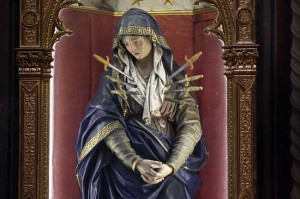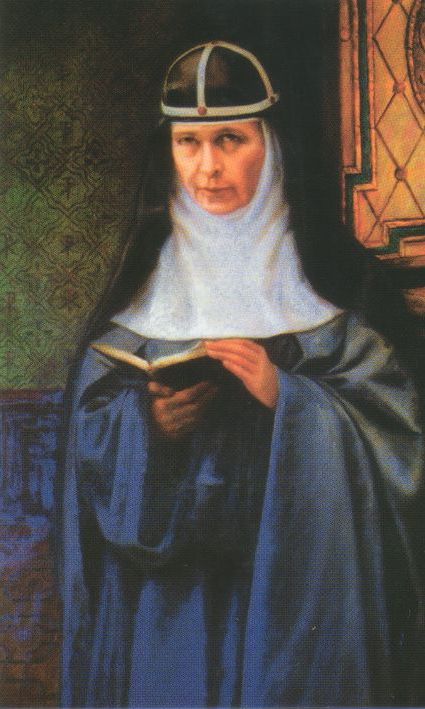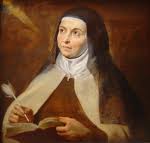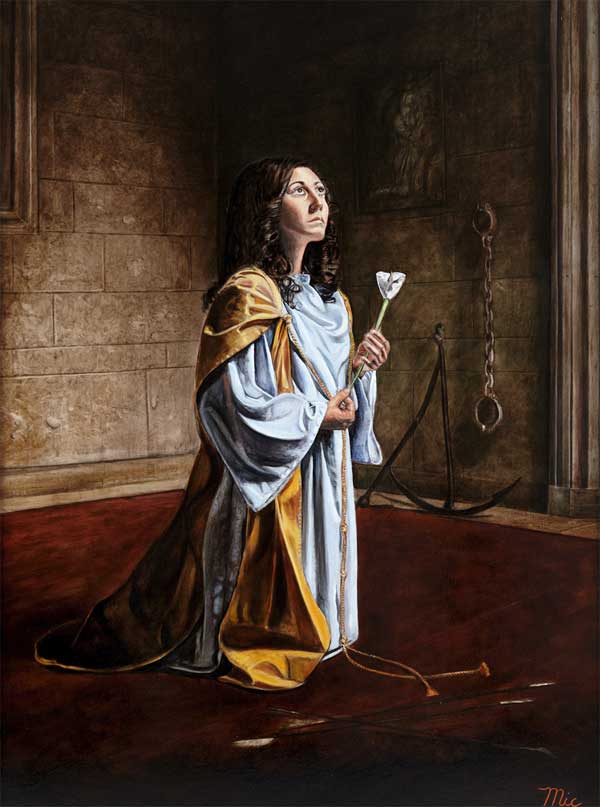The Novena to St. Teresa of Avila, Day 6
composed by  by St. Alphonsus of Liguori.
Join in on Day 6
[powerpress]
O most bountiful Lord Jesus Christ! we thank Thee for the gift of devotion towards Thy sweet 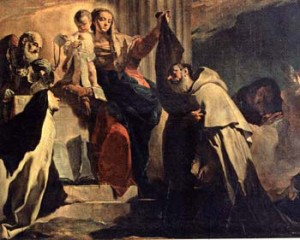 mother, Mary and her holy spouse, Joseph, which Thou didst grant to Thy beloved Teresa; we pray Thee, by Thy merits, and by those of Thy most dear spouse, to give us the grace of a special and tender devotion towards Thy most holy mother, Mary, and towards Thy beloved foster-father, Joseph.
mother, Mary and her holy spouse, Joseph, which Thou didst grant to Thy beloved Teresa; we pray Thee, by Thy merits, and by those of Thy most dear spouse, to give us the grace of a special and tender devotion towards Thy most holy mother, Mary, and towards Thy beloved foster-father, Joseph.
Say one Our Father, Hail Mary and Glory be.
V. St. Teresa, pray for us:
R. That we may become worthy of the promises of Jesus Christ.
Let us pray: Graciously hear us, O God of our salvation! that as we rejoice in the commemoration of the blessed virgin Teresa, so we may be nourished by her heavenly doctrine, and draw from thence the fervour of a tender devotion; through our Lord Jesus Christ, Thy Son, Who liveth and reigneth with Thee in the unity of the Holy Spirit, God for ever and ever. Amen
Tags: catholic, catholic podcast, catholic prayer, cathollc spirituality, devotion, Lord Jesus Christ, novena, prayers
This entry was posted on Saturday, October 11th, 2014 at 12:32 am
You can follow any responses to this entry through the RSS 2.0 feed.
[powerpress]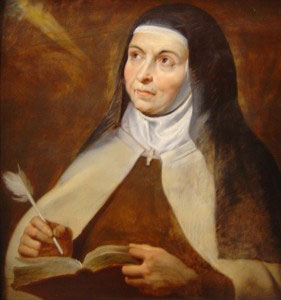
O most amiable Lord Jesus Christ! We thank Thee for the great gift of faith and of devotion to the Holy Sacrament, which Thou didst grant to Thy beloved Teresa; we pray Thee, by Thy merits and by those of Thy faithful spouse, to grant us the gift of a lively faith, and of a fervent devotion toward the most Holy Sacrament of the altar; where Thou, O infinite Majesty! hast obliged Thyself to abide with us even to the end of the world, and wherein Thou didst so lovingly give Thy whole Self to us.
Say one Our Father, Hail Mary and Glory be.
V. St. Teresa, pray for us:
R. That we may become worthy of the promises of Jesus Christ.
Let us pray: Graciously hear us, O God of our salvation! that as we rejoice in the commemoration of the blessed virgin Teresa, so we may be nourished by her heavenly doctrine, and draw from thence the fervour of a tender devotion; through our Lord Jesus Christ, Thy Son, Who liveth and reigneth with Thee in the unity of the Holy Spirit, God for ever and ever. Amen.
This Novena was written by St. Alphonsus of Liguori.
Visit the Discerning Hearts “Teresa of Avila” page for the complete novena and text of the prayers
Tags: catholic, catholic podcast, catholic prayer, cathollc spirituality, devotion, Holy Sacrament, novena, prayers
This entry was posted on Monday, October 6th, 2014 at 12:29 am
You can follow any responses to this entry through the RSS 2.0 feed.
By tradition, the Catholic Church dedicates each month of the year to a certain devotion.
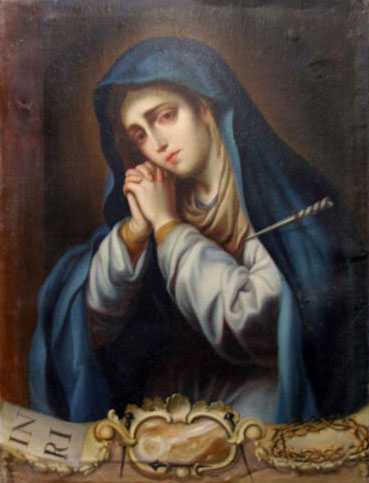 September, the month dedicated to
September, the month dedicated to
Our Lady of Sorrows.
The Memorial of Our Lady of Sorrows takes place on September 15, the day after the Feast of the Triumph of the Cross. We remember the suffering of Mary as she stood at the foot of the Cross and witnessed the torture and death of her Son.
Here is a mediation on the Seven Sorrows of Our Lady that you may wish to join in daily in honor of the Blessed Mother this month…featuring Fr. Mark Cyza and Kris McGregor
[powerpress]
We also are reminded of Simeon’s words to Mary (Luke 2:34-35) at the Presentation of the Lord—that a sword would pierce her soul.
The following prayers can be incorporated into our daily prayers during the Month of Our Lady of Sorrows.
To the Mother of Sorrows
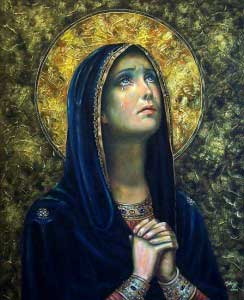 Most holy Virgin and Mother, whose soul was pierced by a sword of sorrow in the Passion of thy divine Son, and who in His glorious Resurrection wast filled with never-ending joy at His triumph; obtain for us who call upon thee, so to be partakers in the adversities of Holy Church and the sorrows of the Sovereign Pontiff, as to be found worthy to rejoice with them in the consolation for which we pray, in the charity and peace of the same Christ our Lord. Amen.
Most holy Virgin and Mother, whose soul was pierced by a sword of sorrow in the Passion of thy divine Son, and who in His glorious Resurrection wast filled with never-ending joy at His triumph; obtain for us who call upon thee, so to be partakers in the adversities of Holy Church and the sorrows of the Sovereign Pontiff, as to be found worthy to rejoice with them in the consolation for which we pray, in the charity and peace of the same Christ our Lord. Amen.
To Our Lady of Sorrows
O most holy Virgin, Mother of our Lord Jesus Christ: by the overwhelming grief you experienced when you witnessed the martyrdom, the crucifixion, and death of your divine Son, look upon me with eyes of compassion, and awaken in my heart a tender commiseration for those sufferings, as well as a sincere detestation of my sins, in order that being disengaged from all undue affection for the passing joys of this earth, I may sigh after the eternal Jerusalem, and that henceforward all my thoughts and all my actions may be directed towards this one most desirable object. Honor, glory, and love to our divine Lord Jesus, and to the holy and immaculate Mother of God. Amen.
To the Queen of Martyrs
Mary, most holy Virgin and Queen of Martyrs, accept the sincere homage of my filial affection. Into thy heart, pierced by so many swords, do thou welcome my poor soul. Receive it as the companion of thy sorrows at the foot of the Cross, on which Jesus died for the redemption of the world. With thee, O sorrowful Virgin, I will gladly suffer all the trials, contradictions, and infirmities which it shall please our Lord to send me. I offer them all to thee in memory of thy sorrows, so that every thought of my mind, and every beat of my heart may be an act of compassion and of love for thee. And do thou, sweet Mother, have pity on me, reconcile me to thy divine Son Jesus, keep me in His grace, and assist me in my last agony, so that I may be able to meet thee in heaven and sing thy glories. Amen.
Tags: catholic, catholic podcast, catholic prayer, cathollc spirituality, daily prayers, death, devotion, holy virgin, month of september, mother of sorrows, our lady of sorrows, prayers, prayers to our lady of sorrows, seven sorrows of our lady, seven sorrows of the blessed virgin mary, suffering
This entry was posted on Monday, September 1st, 2014 at 12:01 am
You can follow any responses to this entry through the RSS 2.0 feed.
Stunning…simply stunning. I love “Mysteries of the Virgin Mary: Living Our Lady’s Graces”! A beautiful and lovingly assembled collection of and meditations on the 13 principal Marian mysteries celebrated by the Church. From the sound theological foundations for our devotion to Our Lady to the reflections and teachings of the saints, Fr. Peter John Cameron, founding editor-in-chief of the monthly worship aid Magnificat, has given us a wonderful resource to deepen our walk with the Blessed Mother of God.
Graces”! A beautiful and lovingly assembled collection of and meditations on the 13 principal Marian mysteries celebrated by the Church. From the sound theological foundations for our devotion to Our Lady to the reflections and teachings of the saints, Fr. Peter John Cameron, founding editor-in-chief of the monthly worship aid Magnificat, has given us a wonderful resource to deepen our walk with the Blessed Mother of God.
[powerpress]
 You kind find this book at www.servantbooks.org
You kind find this book at www.servantbooks.org
Here is the extended web-exclusive edition of our “Inside the Pages” interview with Fr. Cameron[powerpress url=”http://www.old.discerninghearts.com/interviews/Inside_the_Pages-Fr_Peter_John_Cameron_special_extended_edition.mp3″]Download (right click & choose “Save Link As”)
Tags: blessed mother, Church, devotion, graces, marian, meditations, mother of god, mysteries, peter john cameron, reflections, saints, servant books, virgin mary
This entry was posted on Thursday, September 12th, 2013 at 11:13 am
You can follow any responses to this entry through the RSS 2.0 feed.
On Holy Mother Mary
On Holy Repentance
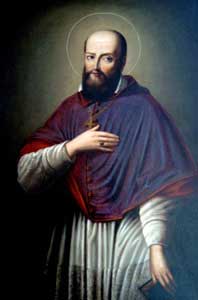 CHAPTER III. Devotion is suitable to every Vocation and Profession.
CHAPTER III. Devotion is suitable to every Vocation and Profession.
WHEN God created the world He commanded each tree to bear fruit after its kind; 88 Gen. i. 12. and even so He bids Christians,—the living trees of His Church,—to bring forth fruits of devotion, each one according to his kind and vocation.
A different exercise of devotion is required of each—the noble, the artisan, the 9 servant, the prince, the maiden and the wife; and furthermore such practice must be modified according to the strength, the calling, and the duties of each individual.
I ask you, my child, would it be fitting that a Bishop should seek to lead the solitary life of a Carthusian? And if the father of a family were as regardless in making provision for the future as a Capucin, if the artisan spent the day in church like a Religious, if the Religious involved himself in all manner of business on his neighbour’s behalf as a Bishop is called upon to do, would not such a devotion be ridiculous, ill-regulated, and intolerable? Nevertheless such a mistake is often made, and the world, which cannot or will not discriminate between real devotion and the indiscretion of those who fancy themselves devout, grumbles and finds fault with devotion, which is really nowise concerned in these errors.
No indeed, my child, the devotion which is true hinders nothing, but on the contrary it perfects everything; and that which runs counter to the rightful vocation of any one is, you may be sure, a spurious devotion.
Aristotle says that the bee sucks honey from flowers without damaging them, leaving them as whole and fresh as it found them;—but true devotion does better still, for it not only hinders no manner of vocation or duty, but, contrariwise, it adorns and beautifies all.
Throw precious 10 stones into honey, and each will grow more brilliant according to its several colour:—and in like manner everybody fulfils his special calling better when subject to the influence of devotion:—family duties are lighter, married love truer, service to our King more faithful, every kind of occupation more acceptable and better performed where that is the guide.
It is an error, nay more, a very heresy, to seek to banish the devout life from the soldier’s guardroom, the mechanic’s workshop, the prince’s court, or the domestic hearth. Of course a purely contemplative devotion, such as is specially proper to the religious and monastic life, cannot be practised in these outer vocations, but there are various other kinds of devotion well-suited to lead those whose calling is secular, along the paths of perfection. The Old Testament furnishes us examples in Abraham, Isaac and Jacob, David, Job, Tobias, Sarah, Rebecca and Judith; and in the New Testament we read of St. Joseph, Lydia and Crispus, who led a perfectly devout life in their trades:—we have S. Anne, Martha, S. Monica, Aquila and Priscilla, as examples of household devotion, Cornelius, S. Sebastian, and S. Maurice among soldiers;—Constantine, S. Helena, S. Louis, the Blessed Amadaeus, 99 It is probable that S. Francis here means to indicate Amadeo IX., Duke of Savoy, who died 1472. and 11 S. Edward on the throne. And we even find instances of some who fell away in solitude,—usually so helpful to perfection,—some who had led a higher life in the world, which seems so antagonistic to it. S. Gregory dwells on how Lot, who had kept himself pure in the city, fell in his mountain solitude. Be sure that wheresoever our lot is cast we may and must aim at the perfect life.
Check out other Discerning Hearts Posts on St. Francis de Sales
[p2p type=”id” value=”2281″]
[p2p type=”id” value=”2622″]
Meditations from the Introduction to the Devout Life by St. Francis de Sales
Tags: chapter xix, devotion, family, heresy, holy mother mary, introduction to the devout life, love, repentance, st francis de sales
This entry was posted on Thursday, January 24th, 2013 at 12:07 am
You can follow any responses to this entry through the RSS 2.0 feed.
Be sure to visit the St. Bridget Discerning Hearts page!!!
And here is an earlier Discerning Hearts post on St. Bridget!
Vatican City, Oct 27, 2010 Pope Benedict’s General Audience from vatican.va
Saint Bridget of Sweden
Dear Brothers and Sisters,
On the eve of the Great Jubilee in anticipation of the Year 2000 the Venerable Servant of God John Paul II proclaimed St Bridget of Sweden Co-Patroness of the whole of Europe. This morning I would like to present her, her message and the reasons why — still today — this holy woman has much to teach the Church and the world.
We are well acquainted with the events of St Bridget’s life because her spiritual fathers compiled her biography in order to further the process of her canonization immediately after her death in 1373. Bridget was born 70 years earlier, in 1303, in Finster, Sweden, a Northern European nation that for three centuries had welcomed the Christian faith with the same enthusiasm as that with which the Saint had received it from her parents, very devout people who belonged to noble families closely related to the reigning house.
We can distinguished two periods in this Saint’s life.
The first was characterized by her happily married state. Her husband was called Ulf and he was Governor of an important district of the Kingdom of Sweden. The marriage lasted for 28 years, until Ulf’s death. Eight children were born, the second of whom, Karin (Catherine), is venerated as a Saint. This is an eloquent sign of Bridget’s dedication to her children’s education. Moreover, King Magnus of Sweden so appreciated her pedagogical wisdom that he summoned her to Court for a time, so that she could introduce his young wife, Blanche of Namur, to Swedish culture. Bridget, who was given spiritual guidance by a learned religious who initiated her into the study of the Scriptures, exercised a very positive influence on her family which, thanks to her presence, became a true “domestic churchâ€. Together with her husband she adopted the Rule of the Franciscan Tertiaries. She generously practiced works of charity for the poor; she also founded a hospital. At his wife’s side Ulf’s character improved and he advanced in the Christian life. On their return from a long pilgrimage to Santiago de Compostela, which they made in 1341 with other members of the family, the couple developed a project of living in continence; but a little while later, in the tranquillity of a monastery to which he had retired, Ulf’s earthly life ended. This first period of Bridget’s life helps us to appreciate what today we could describe as an authentic “conjugal spiritualityâ€: together, Christian spouses can make a journey of holiness sustained by the grace of the sacrament of Marriage. It is often the woman, as happened in the life of St Bridget and Ulf, who with her religious sensitivity, delicacy and gentleness succeeds in persuading her husband to follow a path of faith. I am thinking with gratitude of the many women who, day after day, illuminate their families with their witness of Christian life, in our time too. May the Lord’s Spirit still inspire holiness in Christian spouses today, to show the world the beauty of marriage lived in accordance with the Gospel values: love, tenderness, reciprocal help, fruitfulness in begetting and in raising children, openness and solidarity to the world and participation in the life of the Church. (more…)
Tags: Bridget Discerning Hearts, catholic, catholic podcast, catholic prayer, cathollc spirituality, devotion, love, motherhood
This entry was posted on Monday, July 23rd, 2012 at 6:40 am
You can follow any responses to this entry through the RSS 2.0 feed.
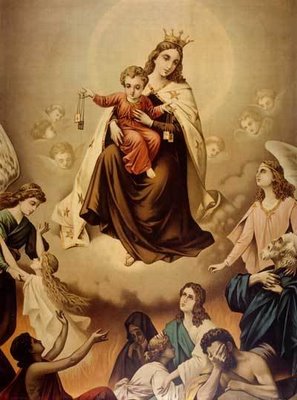 The Feast of Our Lady of Mount Carmel…
The Feast of Our Lady of Mount Carmel…
A prayer to Our Lady of Mt. Carmel
[powerpress]
from About.com
“According to the traditions of the Carmelite order, on July 16, 1251, the Blessed Virgin Mary appeared to St. Simon Stock, a Carmelite. During the vision, she revealed to him the Scapularof Our Lady of Mount Carmel, popularly known as the “Brown Scapular.” A century and a quarter later, the Carmelite order began to celebrate on this date the Feast of Our Lady of Mount Carmel.
The Carmelites had long claimed that their order extended back to ancient times-indeed, that it was founded on Mount Carmel in Palestine by the prophets Elijah and Elisha. While others disputed this idea, Pope Honorius III, in approving the order in 1226, seemed to accept its antiquity. The celebration of the feast became wrapped up with this controversy, and, in 1609, after Robert Cardinal Bellarmine examined the origins of the feast, it was declared the patronal feast of the Carmelite order.
The feast celebrates the devotion that the Blessed Virgin Mary has to those who are devoted to her, and who signal that devotion by wearing the Brown Scapular. According to tradition, those who wear the scapular faithfully and remain devoted to the Blessed Virgin until death will be granted the grace of final perseverance and be delivered from Purgatory early.”
I’m all about the cloth scapular rather than the medal or wood ones. It’s intent is to be a habit…who wears metal or wood clothing? I realize papal permission was given to wear the medal instead, but that was for missionaries in the jungle where the climate disintigrated the cloth quickly.  Really, would it really be a big problem, for those committed to the devotion, to wear the cloth scapular for solidarity sake?  Anyway…
Here are a few of the Carmelites dearest to our hearts:
Also THE SIXTEEN CARMELITE MARTYRS OF COMPIEGNE, but that’s tomorrow….
Tags: blessed virgin mary, brown scapular, catholic, catholic podcast, catholic prayer, cathollc spirituality, devotion, lady of mount carmel, Simon Stock
This entry was posted on Monday, July 16th, 2012 at 12:07 am
You can follow any responses to this entry through the RSS 2.0 feed.
.
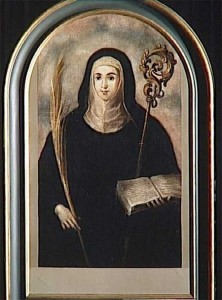 see also Pope Benedict’s teachings on St. Gertrude on the Discerning Hearts Holy Women page
see also Pope Benedict’s teachings on St. Gertrude on the Discerning Hearts Holy Women page
(1256-1302 A.D.) Few men have merited the title, “the Great”; fewer women. I know of only one nun so honored, St. Gertrude of Helfta, a mystic whose spiritual writings have remained influential up to the present.
Nothing is known of this German woman’s family background. When five years old, she was entrusted to the sisters of Helfta Abbey to be educated. From a very young age she gave evidence of her brilliance and quickly outstripped her companions. In her teen years she asked to join the community. Therefore, she probably spent her whole life from childhood on within the abbey walls.
Her love for secular studies made the common life wearisome, pride and vanity ate away at her soul and she soon became an unhappy young woman until Christ appeared to her. The day was branded in her memory, it was in her 26th year, when as she says “in a happy hour, at the beginning of twilight, thou O God of truth, more radiant than any light, yet deeper than any secret thing, determined to dissolve the obscurity of my darkness.” From then on her biographer tells us “she became a theologian instead of a grammarian.” She did not give up her intellectual ardor but now, all her labors were for her sisters, to cure what she termed “the wound of ignorance”. Her many gifts and mystical graces did not prevent her from giving herself wholeheartedly to the common life with its joys and sorrows. In fact many of her special graces came to her as she took part in the ordinary routine of convent life. She felt keenly for those whose burdens involved them in distracting duties, for example those responsible for meeting the debts of the monastery.
She prayed that they might have more time to pray and fewer distractions. The Lord’s answered “It does not matter to me whether you perform spiritual exercises or manual labor, provided only that your will is directed to me with a right intention. If I took pleasure only in your spiritual exercises, I should certainly have reformed human nature after Adam’s fall so that it would not need food, clothing or the other things that man must find or make with such effort.”
Many of her writings are lost, but fortunately she left to the world an abundance of spiritual joy in her book The Herald of Divine Love, in which she tells of the visions granted her by our divine Lord. She wrote this excellent, small book because she was told that nothing was given to her for her own sake only. Her Exercises is an excellent treatise on the renewal of baptismal vows, spiritual conversion, religious vows, love, praise, gratitude to God, reparation, and preparation for death.
She began to record her supernatural and mystical experiences in what eventually became her Book of Extraordinary Grace (Revelation of Saint Gertrude), together with Mechtilde’s mystical experiences Liber Specialis Gratiae, which Gertrude recorded. Most of the book was actually written by others based on Gertrude’s notes. She also wrote with or for Saint Mechtilde a series of prayers that became very popular, and through her writings helped spread devotion to the Sacred Heart (though it was not so called until revealed to St. Margaret Mary Alocoque).
Gertrude is inseparably associated with the devotion to the Sacred Heart. The pierced hear
t of Jesus embodied for her the Divine Love, an inexhaustible fountain of redemptive life. Her visions and insights in connection with the Heart of Jesus are very enlightening. In one such intellectual vision, she perceived the unceasing love of Christ for us in two pulsations of his Heart – one accomplished the conversion of sinners, the other the sanctification of the just. Just as our own faithful heart keeps right on whether we advert to it or not, these pulsations will endure till the end of time despite the vicissitudes of history.
Our Lord wishes people to pray for the souls in purgatory. He once showed Gertrude a table of gold on which were many costly pearls. The pearls were prayers for the holy souls. At the same time the saint had a vision of souls freed from suffering and ascending in the form of bright sparks to heaven.
In one Vision, Our Lord tells Gertrude that he longs for someone to ask Him to release souls from purgatory, just as a king who imprisons a friend for justice’s sake hopes that someone will beg for mercy for his friend. Jesus ends with:
“I accept with highest pleasure what is offered to Me for the poor souls, for I long inexpressibly to have near Me those for whom I paid so great a price. By the prayers of thy loving soul, I am induced to free a prisoner from purgatory as often as thou dost move thy tongue to utter a word of prayer.” (more…)
Tags: benedictine, catholic, catholic podcast, catholic prayer, cathollc spirituality, devotion, family, jesus christ, love, mystic of the Church, mystical experiences, sacred heart, sacred heart of jesus, spiritual exercises, spiritual writings, st gertrude, women of the middle ages
This entry was posted on Wednesday, November 16th, 2011 at 2:30 am
You can follow any responses to this entry through the RSS 2.0 feed.
Be sure to visit the St. Bridget Discerning Hearts page!!!
And here is an earlier Discerning Hearts post on St. Bridget!
Vatican City, Oct 27, 2010 Pope Benedict’s General Audience from vatican.va
Saint Bridget of Sweden
Dear Brothers and Sisters,
On the eve of the Great Jubilee in anticipation of the Year 2000 the Venerable Servant of God John Paul II proclaimed St Bridget of Sweden Co-Patroness of the whole of Europe. This morning I would like to present her, her message and the reasons why — still today — this holy woman has much to teach the Church and the world.
We are well acquainted with the events of St Bridget’s life because her spiritual fathers compiled her biography in order to further the process of her canonization immediately after her death in 1373. Bridget was born 70 years earlier, in 1303, in Finster, Sweden, a Northern European nation that for three centuries had welcomed the Christian faith with the same enthusiasm as that with which the Saint had received it from her parents, very devout people who belonged to noble families closely related to the reigning house.
We can distinguished two periods in this Saint’s life.
The first was characterized by her happily married state. Her husband was called Ulf and he was Governor of an important district of the Kingdom of Sweden. The marriage lasted for 28 years, until Ulf’s death. Eight children were born, the second of whom, Karin (Catherine), is venerated as a Saint. This is an eloquent sign of Bridget’s dedication to her children’s education. Moreover, King Magnus of Sweden so appreciated her pedagogical wisdom that he summoned her to Court for a time, so that she could introduce his young wife, Blanche of Namur, to Swedish culture. Bridget, who was given spiritual guidance by a learned religious who initiated her into the study of the Scriptures, exercised a very positive influence on her family which, thanks to her presence, became a true “domestic churchâ€. Together with her husband she adopted the Rule of the Franciscan Tertiaries. She generously practiced works of charity for the poor; she also founded a hospital. At his wife’s side Ulf’s character improved and he advanced in the Christian life. On their return from a long pilgrimage to Santiago de Compostela, which they made in 1341 with other members of the family, the couple developed a project of living in continence; but a little while later, in the tranquillity of a monastery to which he had retired, Ulf’s earthly life ended. This first period of Bridget’s life helps us to appreciate what today we could describe as an authentic “conjugal spiritualityâ€: together, Christian spouses can make a journey of holiness sustained by the grace of the sacrament of Marriage. It is often the woman, as happened in the life of St Bridget and Ulf, who with her religious sensitivity, delicacy and gentleness succeeds in persuading her husband to follow a path of faith. I am thinking with gratitude of the many women who, day after day, illuminate their families with their witness of Christian life, in our time too. May the Lord’s Spirit still inspire holiness in Christian spouses today, to show the world the beauty of marriage lived in accordance with the Gospel values: love, tenderness, reciprocal help, fruitfulness in begetting and in raising children, openness and solidarity to the world and participation in the life of the Church.
The second period of Bridget’s life began when she was widowed. She did not consider another marriage in order to deepen her union with the Lord through prayer, penance and charitable works. Therefore Christian widows too may find in this Saint a model to follow. In fact, upon the death of her husband, after distributing her possessions to the poor — although she never became a consecrated religious — Bridget settled near the Cistercian Monastery of Alvastra. Here began the divine revelations that were to accompany her for the rest of her life. Bridget dictated them to her confessors-secretaries, who translated them from Swedish into Latin and gathered them in eight volumes entitled Revelationes (Revelations). A supplement followed these books called, precisely,Revelationes extravagantes (Supplementary revelations).
St Bridget’s Revelations have a very varied content and style. At times the revelations are presented in the form of dialogues between the divine Persons, the Virgin, the Saints and even demons; they are dialogues in which Bridget also takes part. At other times, instead, a specific vision is described; and in yet others what the Virgin Mary reveals to her concerning the life and mysteries of the Son.
The value of St Bridget’s Revelations, sometimes the object of criticism Venerable John Paul II explained in his Letter Spes Aedificandi: “The Church, which recognized Bridget’s holiness without ever pronouncing on her individual revelations, has accepted the overall authenticity of her interior experience†(n. 5). Indeed, reading these Revelations challenges us on many important topics. For example, the description of Christ’s Passion, with very realistic details, frequently recurs. Bridget always had a special devotion to Christ’s Passion, contemplating in it God’s infinite love for human beings. She boldly places these words on the lips of the Lord who speaks to her: “O my friends, I love my sheep so tenderly that were it possible I would die many other times for each one of them that same death I suffered for the redemption of all†(Revelationes, Book I, c. 59). The sorrowful motherhood of Mary, which made her Mediatrix and Mother of Mercy, is also a subject that recurs frequently in the Revelations.
In receiving these charisms, Bridget was aware that she had been given a gift of special love on the Lord’s part: “My Daughter†— we read in the First Book of Revelations — “I have chosen you for myself, love me with all your heart… more than all that exists in the world†(c. 1). Bridget, moreover, knew well and was firmly convinced that every charism is destined to build up the Church. For this very reason many of her revelations were addressed in the form of admonishments, even severe ones, to the believers of her time, including the Religious and Political Authorities, that they might live a consistent Christian life; but she always reprimanded them with an attitude of respect and of full fidelity to the Magisterium of the Church and in particular to the Successor of the Apostle Peter.
In 1349 Bridget left Sweden for good and went on pilgrimage to Rome. She was not only intending to take part in the Jubilee of the Year 1350 but also wished to obtain from the Pope approval for the Rule of a Religious Order that she was intending to found, called after the Holy Saviour and made up of monks and nuns under the authority of the Abbess. This is an element we should not find surprising: in the Middle Ages monastic foundations existed with both male and female branches, but with the practice of the same monastic Rule that provided for the Abbess’ direction. In fact, in the great Christian tradition the woman is accorded special dignity and — always based on the example of Mary, Queen of Apostles — a place of her own in the Church, which, without coinciding with the ordained priesthood is equally important for the spiritual growth of the Community. Furthermore, the collaboration of consecrated men and women, always with respect for their specific vocation, is of great importance in the contemporary world. In Rome, in the company of her daughter Karin, Bridget dedicated herself to a life of intense apostolate and prayer. And from Rome she went on pilgrimage to various Italian Shrines, in particular to Assisi, the homeland of St Francis for whom Bridget had always had great devotion. Finally, in 1371, her deepest desire was crowned: to travel to the Holy Land, to which she went accompanied by her spiritual children, a group that Bridget called “the friends of Godâ€. In those years the Pontiffs lived at Avignon, a long way from Rome: Bridget addressed a heartfelt plea to them to return to the See of Peter, in the Eternal City. She died in 1373, before Pope Gregory XI returned to Rome definitively. She was buried temporarily in the Church of San Lorenzo in Panisperna in Rome but in 1374 her children, Birger and Karin, took her body back to her homeland, to the Monastery of Vadstena, the headquarters of the Religious Order St Bridget had founded. The order immediately experienced a considerable expansion. In 1391 Pope Boniface IX solemnly canonized her. Bridget’s holiness, characterized by the multiplicity of her gifts and the experiences that I have wished to recall in this brief biographical and spiritual outline, makes her an eminent figure in European history. In coming from Scandinavia, St Bridget bears witness to the way Christianity had deeply permeated the life of all the peoples of this Continent. In declaring her Co-Patroness of Europe, Pope John Paul II hoped that St Bridget — who lived in the 14th century when Western Christianity had not yet been wounded by division — may intercede effectively with God to obtain the grace of full Christian unity so deeply longed for.
Let us pray, dear brothers and sisters, for this same intention, which we have very much at heart, and that Europe may always be nourished by its Christian roots, invoking the powerful intercession of St Bridget of Sweden, a faithful disciple of God and Co-Patroness of Europe. Thank you for your attention.
Tags: Bridget Discerning Hearts, catholic, catholic podcast, catholic prayer, cathollc spirituality, devotion, holy women, love, motherhood, mystic, mystic of the Church, mystical expeeriences, mystical experiences, mystical revelations, pope benedict xvi, st bridget of sweden, St. Bridget, Sweden, women of the middle ages
This entry was posted on Wednesday, October 27th, 2010 at 6:07 pm
You can follow any responses to this entry through the RSS 2.0 feed.
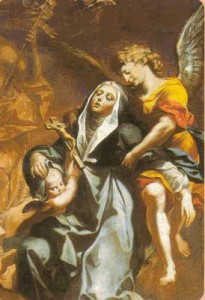 There’s somethng that happens when you not only read and recite but when you also hear…when you listen deeply and profoundly. The private revelation which was given to St. Bridget of Sweden that day in the chapel of the church of St. Paul’s Outside the Walls in Rome over 600 years ago is still one of the most poignant and compelling moments in all mystical experiences. The Church has deemed this worthy of belief to the extent that it can edify one’s faith rather than hurt; that indeed if practiced and nurtured it could open the heart for an outpouring of grace.
There’s somethng that happens when you not only read and recite but when you also hear…when you listen deeply and profoundly. The private revelation which was given to St. Bridget of Sweden that day in the chapel of the church of St. Paul’s Outside the Walls in Rome over 600 years ago is still one of the most poignant and compelling moments in all mystical experiences. The Church has deemed this worthy of belief to the extent that it can edify one’s faith rather than hurt; that indeed if practiced and nurtured it could open the heart for an outpouring of grace.
The “Pieta Prayers” of St. Bridget of Sweden can be a challenging practice in today’s world. To help foster a greater understanding and devotion to Our Lord’s Passion, Discerning Hearts has produced a MP3 Downloadable audio which we hope will assist you in some way.
[powerpress = “Devotionals-Prayers”]Â (featuring Bruce McGregor and Denise Wharton)
For the complete texts, promises and ecclesial advisements click here
Tags: 15 prayers of st bridget, catholic, catholic podcast, catholic prayer, cathollc spirituality, devotion, Discerning Hearts, hope, mp3 downloadable, mystic, mystic of the Church, mystical experiences, pieta, prayers, private revelation, st bridget of sweden, Sweden, women of the middle ages
This entry was posted on Saturday, September 18th, 2010 at 5:12 pm
You can follow any responses to this entry through the RSS 2.0 feed.
Despite the “lack of historical evidence” surrounding St. Philomena, the heart just “knows”.  The  relationships that this lovely little saint has had with us in the temporal order from her seat in the Cloud of Witnesses is the greatest evidence of all for her presence there.  The great Cure de Ars, St. John Vianney, had a great devotion to St. Philomena, along with many, many others.  Beloved St. Philomena, pray for us!
Tags: catholic, catholic podcast, catholic prayer, cathollc spirituality, cloud of witnesses, devotion, st john vianney, St. Philomena
This entry was posted on Wednesday, August 11th, 2010 at 9:27 am
You can follow any responses to this entry through the RSS 2.0 feed.

